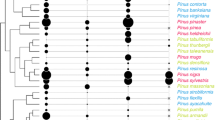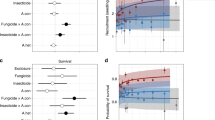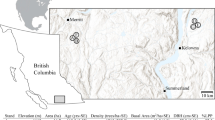Abstract
Tree diversity is one of the drivers of forest resistance to herbivores. Most of the current understanding of the diversity resistance relationship comes primarily from short-term studies. Knowing whether tree diversity effects on herbivores are maintained over time is important for perennial ecosystems like forests. We addressed the temporal dynamics of the diversity resistance relationship by conducting a 6-year survey of pine attacks by the pine processionary moth Thaumetopoea pityocampa (PPM) in a tree diversity experiment where we could disentangle tree composition from host density effects. During the first years after planting the trees, PPM attacks on maritime pine Pinus pinaster were reduced in the presence of birch Betula pendula, a fast-growing non-host tree (i.e. associational resistance). This effect was maintained but faded with time as the pines eventually grew taller than neighbouring birches. The number of repeated attacks on individual pine trees also decreased in mixed pine–birch stands. Pine density had a positive effect on stand colonisation by PPM and a negative effect on the proportion of trees that were attacked. Pines were less likely to be repeatedly attacked as pine density increased, with attacks being spread over a larger number of host trees. Collectively, these results unravel the independent contribution of tree species composition and host density to tree resistance to herbivores. Both processes had directional changes over time. These results indicate that the resistance of planted forests to herbivores can be improved by carefully choosing the composition of mixed forests and the timing of species planting.




Similar content being viewed by others
References
Bañuelos M-J, Kollmann J (2011) Effects of host-plant population size and plant sex on a specialist leaf-miner. Acta Oecol 37:58–64. https://doi.org/10.1016/j.actao.2010.11.007
Barbosa P, Hines J, Kaplan I et al (2009) Associational resistance and associational susceptibility: having right or wrong neighbors. Annu Rev Ecol Evol Syst 40:1–20. https://doi.org/10.1146/annurev.ecolsys.110308.120242
Bartoń K (2019) MuMIn: multi-model inference. R package version 1.43.6. https://CRAN.R-project.org/package=MuMIn
Battisti A, Avcı M, Avtzis DN et al (2015) Natural history of the processionary moths (Thaumetopoea spp.): new insights in relation to climate change. In: Roques A (ed) Processionary moths and climate change: an update. Springer, Dordrecht, pp 15–79
Bognounou F, De Grandpré L, Pureswaran DS, Kneeshaw D (2017) Temporal variation in plant neighborhood effects on the defoliation of primary and secondary hosts by an insect pest. Ecosphere 8:e01759. https://doi.org/10.1002/ecs2.1759
Bommarco R, Banks JE (2003) Scale as modifier in vegetation diversity experiments: effects on herbivores and predators. Oikos 102:440–448
Castagneyrol B, Giffard B, Péré C, Jactel H (2013) Plant apparency, an overlooked driver of associational resistance to insect herbivory. J Ecol 101:418–429. https://doi.org/10.1111/1365-2745.12055
Castagneyrol B, Jactel H, Charbonnier Y et al (2014a) Egg mortality in the pine processionary moth: habitat diversity, microclimate and predation effects: egg mortality in Thaumetopoea pityocampa. Agric For Entomol 16:284–292. https://doi.org/10.1111/afe.12056
Castagneyrol B, Jactel H, Vacher C et al (2014b) Effects of plant phylogenetic diversity on herbivory depend on herbivore specialization. J Appl Ecol 51:134–141. https://doi.org/10.1111/1365-2664.12175
Castagneyrol B, Régolini M, Jactel H (2014c) Tree species composition rather than diversity triggers associational resistance to the pine processionary moth. Basic Appl Ecol 15:516–523. https://doi.org/10.1016/j.baae.2014.06.008
Castagneyrol B, Jactel H, Moreira X (2018) Anti-herbivore defences and insect herbivory: interactive effects of drought and tree neighbours. J Ecol 106:2043–2055. https://doi.org/10.1111/1365-2745.12956
Damien M, Jactel H, Meredieu C et al (2016) Pest damage in mixed forests: disentangling the effects of neighbor identity, host density and host apparency at different spatial scales. For Ecol Manag 378:103–110. https://doi.org/10.1016/j.foreco.2016.07.025
Dulaurent A-M, Porté AJ, van Halder I et al (2012) Hide and seek in forests: colonization by the pine processionary moth is impeded by the presence of nonhost trees. Agric For Entomol 14:19–27. https://doi.org/10.1111/j.1461-9563.2011.00549.x
Feeny P (1976) Plant apparency and chemical defense. In: Wallace J, Mansell R (eds) Biochemical interaction between plants and insects. Springer, Heidelberg, pp 1–40
Fernandez-Conradi P, Jactel H, Hampe A et al (2017) The effect of tree genetic diversity on insect herbivory varies with insect abundance. Ecosphere. https://doi.org/10.1002/ecs2.1637
Finch S, Collier RH (2000) Host-plant selection by insects—a theory based on ‘appropriate/inappropriate landings’ by pest insects of cruciferous plants. Entomol Exp Appl 96:91–102. https://doi.org/10.1046/j.1570-7458.2000.00684.x
Guyot V, Castagneyrol B, Vialatte A et al (2016) Tree diversity reduces pest damage in mature forests across Europe. Biol Lett 12:20151037. https://doi.org/10.1098/rsbl.2015.1037
Hakes AS, Cronin JT (2012) Successional changes in plant resistance and tolerance to herbivory. Ecology 93:1059–1070
Hambäck PA, Englund G (2005) Patch area, population density and the scaling of migration rates: the resource concentration hypothesis revisited: density-area relations in sources and sinks. Ecol Lett 8:1057–1065. https://doi.org/10.1111/j.1461-0248.2005.00811.x
Hambäck PA, Inouye BD, Andersson P, Underwood N (2014) Effects of plant neighborhoods on plant–herbivore interactions: resource dilution and associational effects. Ecology 95:1370–1383. https://doi.org/10.1890/13-0793.1
Haynes KJ, Allstadt AJ, Klimetzek D (2014) Forest defoliator outbreaks under climate change: effects on the frequency and severity of outbreaks of five pine insect pests. Glob Change Biol 20:2004–2018. https://doi.org/10.1111/gcb.12506
Hódar JA, Zamora R, Castro J (2002) Host utilisation by moth and larval survival of pine processionary caterpillar Thaumetopoea pityocampa in relation to food quality in three Pinus species. Ecol Entomol 27:292–301. https://doi.org/10.1046/j.1365-2311.2002.00415.x
Hothorn T, Bretz F, Westfall P (2008) Simultaneous inference in general parametric models. Biom J 50(3):346–363
Jacquet J-S, Bosc A, O’Grady AP, Jactel H (2013) Pine growth response to processionary moth defoliation across a 40-year chronosequence. For Ecol Manag 293:29–38. https://doi.org/10.1016/j.foreco.2012.12.003
Jactel H, Birgersson G, Andersson S, Schlyter F (2011) Non-host volatiles mediate associational resistance to the pine processionary moth. Oecologia 166:703–711
Jactel H, Barbaro L, Battisti A et al (2015) Insect—tree Interactions in Thaumetopoea pityocampa. In: Roques A (ed) Processionary moths and climate change: an update. Springer, Dordrecht, pp 265–310
Jucker T, Bouriaud O, Coomes DA (2015) Crown plasticity enables trees to optimize canopy packing in mixed-species forests. Funct Ecol 29:1078–1086. https://doi.org/10.1111/1365-2435.12428
Kim TN, Underwood N (2014) Plant neighborhood effects on herbivory: damage is both density and frequency dependent. Ecology 96:1431–1437. https://doi.org/10.1890/14-1097.1
Kostenko O, Bezemer TM (2013) Intraspecific variation in plant size, secondary plant compounds, herbivory and parasitoid assemblages during secondary succession. Basic Appl Ecol 14:337–346. https://doi.org/10.1016/j.baae.2013.02.006
Kuznetsova A, Brockhoff PB, Christensen RHB (2017) lmerTest package: tests in linear mixed effects models. J Stat Softw 82(13):1–26. https://doi.org/10.18637/jss.v082.i13
Li S, Daudin JJ, Piou D et al (2015) Periodicity and synchrony of pine processionary moth outbreaks in France. For Ecol Manag 354:309–317. https://doi.org/10.1016/j.foreco.2015.05.023
Merwin AC, Underwood N, Inouye BD (2017) Increased consumer density reduces the strength of neighborhood effects in a model system. Ecology 98:2904–2913. https://doi.org/10.1002/ecy.2004
Miller AM, McArthur C, Smethurst PJ (2007) Effects of within-patch characteristics on the vulnerability of a plant to herbivory. Oikos 116:41–52. https://doi.org/10.1111/j.2006.0030-1299.15331.x
Moreira X, Abdala-Roberts L, Rasmann S et al (2016) Plant diversity effects on insect herbivores and their natural enemies: current thinking, recent findings, and future directions. Curr Opin Insect Sci 14:1–7. https://doi.org/10.1016/j.cois.2015.10.003
Otway SJ, Hector A, Lawton JH (2005) Resource dilution effects on specialist insect herbivores in a grassland biodiversity experiment. J Anim Ecol 74:234–240. https://doi.org/10.1111/j.1365-2656.2005.00913.x
Régolini M, Castagneyrol B, Dulaurent-Mercadal A-M et al (2014) Effect of host tree density and apparency on the probability of attack by the pine processionary moth. For Ecol Manag 334:185–192. https://doi.org/10.1016/j.foreco.2014.08.038
Root RB (1973) Organization of a Plant-arthropod association in simple and diverse habitats: the fauna of collards (Brassica Oleracea). Ecol Monogr 43:95. https://doi.org/10.2307/1942161
Schiebe C, Blaženec M, Jakuš R et al (2011) Semiochemical diversity diverts bark beetle attacks from Norway spruce edges. J Appl Entomol 135:726–737. https://doi.org/10.1111/j.1439-0418.2011.01624.x
Schuldt A, Baruffol M, Böhnke M et al (2010) Tree diversity promotes insect herbivory in subtropical forests of south-east China. J Ecol 98:917–926. https://doi.org/10.1111/j.1365-2745.2010.01659.x
Setiawan NN, Vanhellemont M, Baeten L et al (2014) The effects of local neighbourhood diversity on pest and disease damage of trees in a young experimental forest. For Ecol Manag 334:1–9. https://doi.org/10.1016/j.foreco.2014.08.032
Shaiek O, Loustau D, Trichet P et al (2011) Generalized biomass equations for the main aboveground biomass components of maritime pine across contrasting environments. Ann For Sci 68:443–452. https://doi.org/10.1007/s13595-011-0044-8
Strauss SY, Cacho NI, Schwartz MW et al (2015) Apparency revisited. Entomol Exp Appl. https://doi.org/10.1111/eea.12347
van Schrojenstein Lantman IM, Hertzog LR, Vandegehuchte ML et al (2018) Leaf herbivory is more impacted by forest composition than by tree diversity or edge effects. Basic Appl Ecol 29:79–88. https://doi.org/10.1016/j.baae.2018.03.006
Verschut TA, Becher PG, Anderson P, Hambäck PA (2016) Disentangling associational effects: both resource density and resource frequency affect search behaviour in complex environments. Funct Ecol 30:1826–1833. https://doi.org/10.1111/1365-2435.12670
Wein A, Bauhus J, Bilodeau-Gauthier S et al (2016) Tree species richness promotes invertebrate herbivory on congeneric native and exotic tree saplings in a young diversity experiment. PLoS One 11:e0168751. https://doi.org/10.1371/journal.pone.0168751
Zhang QH, Schlyter F (2003) Redundancy, synergism, and active inhibitory range of non-host volatiles in reducing pheromone attraction in European spruce bark beetle Ips typographus. Oikos 101:299–310. https://doi.org/10.1034/j.1600-0706.2003.111595.x
Zhang QH, Schlyter F (2004) Olfactory recognition and behavioural avoidance of angiosperm nonhost volatiles by conifer-inhabiting bark beetles. Agric for entomol 6:1–20. https://doi.org/10.1111/j.1461-9555.2004.00202.x
Acknowledgements
BC was supported by the GIP-ECOFOR programme from the French ministry of agriculture (Project BIOPICC ECOFOR-2014-15). MT, CP and HJ received support from the French National Research agency (Project DiPTiCC, ANR-16-CE32-0003-01). MVK was supported by the Academy of Finland (Projects 311929 and 316182). We thank people who contributed to count PPM nests since 2013 (with no particular order): Maxime Damien, Inge van Halder, Margot Régoloni, Céline Meredieu, Fabrice Vétillard, Lucile Perrot, Angelina Ceballos-Escalera, Yasmine Kadiri, Christophe Poilleux and Victor Rebillard. The authors acknowledge UEFP 0570, INRA, 69 route d’Arcachon, 33612, CESTAS, for the management of the ORPHEE experiment.
Author information
Authors and Affiliations
Corresponding author
Ethics declarations
Conflict of interest
The authors declare that they have no conflict of interest.
Ethical approval
This article does not contain any studies with animals performed by any of the authors.
Additional information
Communicated by C. Stauffer.
Publisher's Note
Springer Nature remains neutral with regard to jurisdictional claims in published maps and institutional affiliations.
Electronic supplementary material
Below is the link to the electronic supplementary material.
Rights and permissions
About this article
Cite this article
Castagneyrol, B., Kozlov, M.V., Poeydebat, C. et al. Associational resistance to a pest insect fades with time. J Pest Sci 93, 427–437 (2020). https://doi.org/10.1007/s10340-019-01148-y
Received:
Revised:
Accepted:
Published:
Issue Date:
DOI: https://doi.org/10.1007/s10340-019-01148-y




